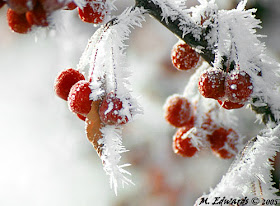Frost can signal that the end of the gardening season is near – but not necessarily over.
I have a good friend who recently said “I am sick of the garden – I just want it to be over.” If this is you, then when frost threatens, by all means do a final harvest of the tenders and call it done. If it’s not you, there are many measures you can take to protect your crops from a killing frost incident, as more times than not, such an incident is followed here by an Indian Summer and at least another month of flower and vegetable enjoyment and harvest.
What is Frost?
Frost is water in the form of dew which freezes on the surfaces of your plants and causes the water in the plants cells to freeze and burst, thus killing the plant.
There are two types of frost, advective and radiation. Advective frost occurs when a cold front sweeps into an area accompanied by gusty winds, sometimes with clouds and a thick layer of cold from the ground up. Radiation frost happens on crystal clear days or nights and not accompanied by wind.
Watch the Weather Forecast
As gardeners, watching the weather is akin to new parents listening to the baby monitor.
We are maniacal about it. We know that the average first frost date for our area is October 15. The first average frost date is the day when there is a 50% chance that a frost will occur. This will vary by 4-5 days the farther south you are in the county and the higher up the mountain you live. Knowing this, keep a sharp ear to the weather forecasts. When the weatherman predicts a cold front following clear nights and low humidity, frost is eminent.
Freeze is defined as 32 plus degrees, light frost, damage depends on the duration of the frost and the humidity present. Light Frost is from 29-32 degrees, tender plants are killed with little effect on the other vegetation. Moderate freeze is 25-28 degrees, damage to most vegetation with heaviest to fruit blossoms and tender plants. Hard Freeze is 24 degrees and below and considered a killing frost – thus ending the season.
Evaluate Your Garden
Decide how much of the tender produce you have left to harvest and how much frost tolerant produce will need protection. Learn the difference so you will no be caught unaware. All vegetables and flowers react differently to frost.
Tender Vegetables – Need protection and diligence when frost threatens; will not live below 32 degrees: tomatoes, beans, cucumbers summer squash, annual flowers, annual herbs, peppers.
The Frost tolerant- Can live when vines, leaves are frozen; can survive temps of 28 degrees and sometimes below; the cruciferous vegetables, cabbage, Brussels sprouts, broccoli, hardy perennial herbs like chives, sages, beets, carrots, winter squashes and pumpkins.
The Cold Hardy– thrives in temps between 32 and 28 degrees with some protection. Flavors tend to improve with the cold: kale, spinach, lettuce, arugula, and chard.
Cover Your Plants
When frost threatens, we grab just about anything we can to cover our plants. Covers can provide up to 5 degrees of extra protection. The best are of woven type fabrics as opposed to plastic or paper, which can do a fair job, better than nothing, in a pinch. The smartest way to apply a frost protection cover is to support it slightly above your crop or tree or container garden with hoops or stakes. This creates an air pocket which buffers the temperature drop. It should be high enough so that the weight of any precipitation that occurs will not touch the plant. Wet fabric can cause the same damage when touching your plant as if the moisture had settled directly on lit. Don’t forget to remove the covers in the morning before the sun comes out.
Irrigate Well Before a Frost
Plants go into a frost much more successfully when the soil around them is moist as opposed to dry. Moist soil holds four times as much heat as dry soil. Moisture also conducts heat to the soil surface by as much as 5 degrees and that difference is maintained into the early morning hours. So, water your plants well the evening before an expected frost.
We are into October and our fickle Colorado weather could spring a frost on us at any moment and then nothing for weeks. It behooves you to protect your plants to reap weeks more of enjoyment of color and harvest. These tips should help you to do that so that you can continue to enjoy our amazing fall with the confidence that your plants will succeed as well.



